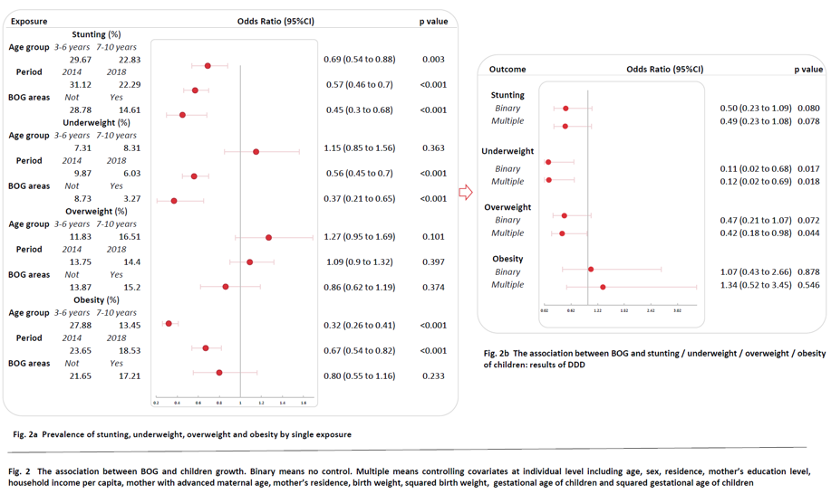What is the association between Olympic Games and children’s growth? Looking at evidence from China
In this blog we will share the study (recently published in BJSM) about the association between the 2008 Beijing Olympic Games (BOG) and growth of children in China. It found that the BOG was positively associated with healthier growth of children including decreased risks of both undernutrition and overnutrition.
Why is this study important?
Shortly after the Tokyo Olympic Games, the Beijing Winter Olympic Games and Paralympic Games have been held in February 2022. Previously, public health experts have expressed great concerns over the safety of the Tokyo Olympic Games amid the COVID- 19 pandemic and appealed for a global conversation on it.1 Although mass gatherings have potential risks amid a global health crisis, the legacy of health concepts, services and facilities of the Games with well public health preparedness might contribute to population health in which they are hosted, including children’s growth. Several previous studies investigated the association between Olympic Games and public health such as exposure to respirable particulate matter, adolescent psychological health and asthma, but none studied the long- term association of Olympic Games and child growth.
The present study, using the BOG as a natural experiment, was designed to capture the potential long- term association of Olympic Games and children’s growth at the population level via the difference-in-difference-in-differences (DDD) method, established by examining the regional variations of Olympic Games exposure across age groups and survey periods. The investigation of the relationship between the BOG after SARS and health can provide implications for the follow-up influence of the Beijing Winter Olympic Games during this epidemic given that both games were held in China, although there are differences in the type of Olympic Games and the status of the pandemics. This research will also help us to assess the association of the Olympic Games and children’s growth more comprehensively.
How did the study go about this?
The existence of the 2008 BOG in China was used as a natural experiment since it is exogenous for any individual and is suitable to obtain an appropriate counterfactual condition to estimate its influence. Individual-level data were obtained from the China Family Panel Studies (CFPS). Figure 1 illustrates the derivation of our analytical sample. The association between the BOG and children’s growth was estimated by comparing the variations of outcomes across triple BOG-related differences including the age groups, periods and living areas where the children were investigated.

What did the study find?
Among the analyzed children, the prevalence rates of stunting, underweight, overweight and obesity were 7.80%, 26.36%, 14.10% and 20.89%. The prevalence rates of the above four indicators by single difference from age groups, survey period or BOG areas were shown in figure 2A. Figure 2B presents the DDD estimates of the association between the BOG and stunting, underweight, overweight and obesity of children. BOG exposure was found significantly associated with decreased risk of children’s underweight (OR 0.12, 95% CI 0.02 to 0.69) and overweight (OR 0.42; 95% CI 0.18 to 0.98) after controlling for multiple covariates. The association between being exposed to the BOG and odds of stunting and obesity was not statistically significant.

Sex heterogeneity of associations between the BOG and stunting, underweight or overweight was not found (p for interaction>0.05). However, there was significant sex heterogeneity (p for interaction<0.05) with regard to the association between the BOG and child obesity, that is, significant lower risk of obesity was found in female sample (OR 0.24; 95% CI 0.06 to 0.94 in fractional polynomial model) but not in male sample.
What are the key take-home points?
The 2008 Beijing Olympic Games was associated with decreased risks of underweight and overweight of children. Female children appeared to benefit more from the potential preventative role of 2008 Beijing Olympic Games on obesity compared with male counterpart. The host countries of future Olympic Games could carry forward the Olympic health legacy with greater focus on the potential positive effects on childhood growth and development. Besides, further studies are needed to follow the public health impacts of Olympic Games in the longer term and throughout the age spectrum.
Paper information:
Guo C, Hu X, Xu C, Zheng X. Association between Olympic Games and children’s growth: evidence from China. British Journal of Sports Medicine 2022. doi: 10.1136/bjsports-2021-104844
Author and Affiliations:
Chao Guo, Xiyuan Hu, Chaofan Xu, Xiaoying Zheng
Institute of Population Research, Peking University, Beijing 100871, China.
Contact: Dr Chao Guo, chaoguo@pku.edu.cn